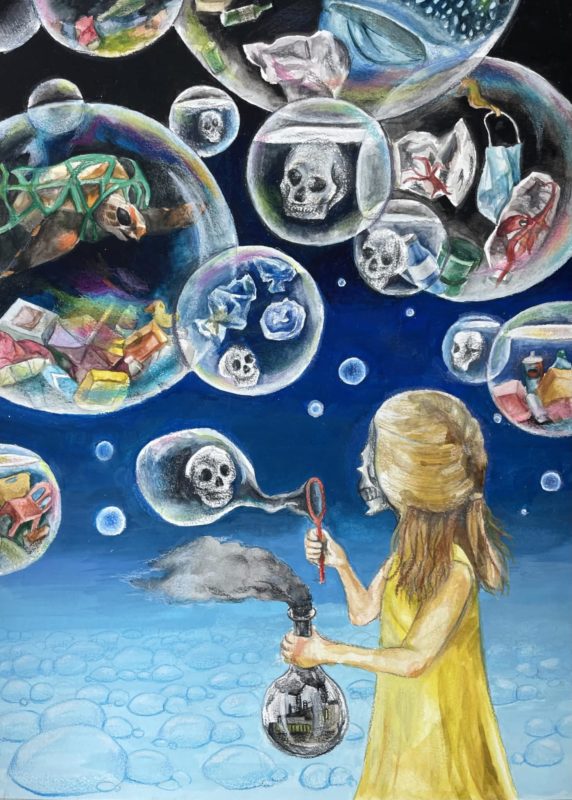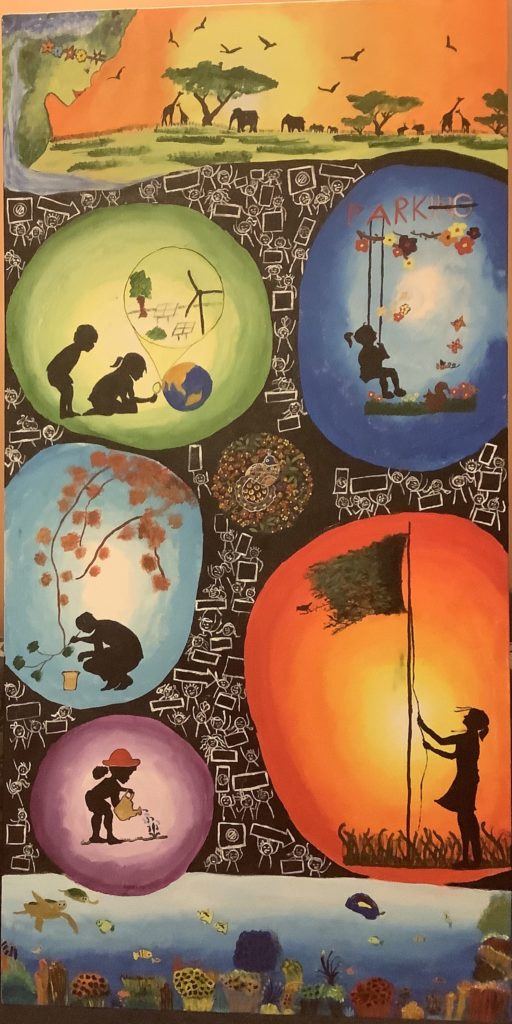
Why the Climate Crisis is a Child Rights Crisis
February 16, 2023By Dhruv Bhatt, 2023 Future Blue Youth Council member
Featured Image: “Submerging Memory” by Yongha Cho (Georgia, USA)
I was born in India, but my earliest memories are of the glittering beaches of Lagos. Of the countless vendors who wade through the crowd selling prawns, coconuts, or plantain chips. Of ever-warm and humid days punctuated only by the dry Harmattan or an uncommon violent shower. These memories are so vividly set in my mind that it is almost impossible for me to accept that Nigerian children are among the most vulnerable to environmental stresses in the world!
International agreements like the United Nations Convention on the Rights of the Child define a child as “any person under the age of 18.” They guarantee each child the right to a safe, sustainable, and healthy environment. However, nearly half of us live in one of the 33 countries that are at an “extremely high risk” from the impacts of climate change. One-third of us face water scarcity, and a shocking 90 percent are highly exposed to air pollution.

‘Lost Childhood’ by Yeonseo Hyun (California, USA)
Unfortunately, these environmental stresses do not function in isolation. Instead, they overlap with existing social and economic inequalities, pushing children into a vicious cycle of poverty and climate vulnerability. This is particularly evident in countries like Ethiopia, where 20% of girls drop out of school as they are traditionally required to fetch water. Furthermore, many countries show a surge in child marriage following weather-related natural disasters. For example, in poverty-stricken South Sudan, parents exchange their daughters for the highest number of cows for subsistence in the face of the looming climate catastrophe. This lack of education and protection early in our lives can significantly reduce our potential for productive and successful careers as adults.
In addition to exacerbating local inequalities, climate change actively widens the international divide between the developing and developed world. As an Indian climate justice and child rights activist, I have often faced issues such as poor internet connectivity, reduced capacity to travel to international conferences, and inadequate to no media coverage of child-led protests. These barriers mean that the children least responsible but most affected by the crisis will never be heard.
Climate change is also directly correlated with increased abuse and violence against children, especially in low-income climate-vulnerable regions of the Global South. In the Pacific alone, 50,000 people flee their homes every year. How many of these displaced children find new homes and build new lives? Last year, on International Children’s Day, I wrote this poem in their memory:
“Four full cups of raging seas
of cramped bodies and rickety boats
of babies nestled in laundry baskets
set to sail in search of shores.”
“A world that turns from fog to Fall
from droughts to floods to empty calls
Of change, of dreams, of a world we deserve
Of hopes and lives, we sought to preserve.”
These statistics and chilling examples only quantify what children have been advocating for decades: the climate crisis IS a child rights crisis. It is a water, education, protection, participation, security, and health crisis! How can we play, learn, or even survive in such a world?
Despite the disheartening climate reality, we choose to move beyond the bad news. After all, we are the Earth’s canaries in the coal mines: we feel the extent of the crisis in our daily lives. We are taking to the streets and protesting online. We are angry and frustrated, ignored and silenced. But we are not scared to call out the previous generations’ misplaced values, where economic development ranks higher than the overall well-being of children and the Earth.

‘Enlightened World’ by Aarav Dengla (India)
Solving the climate crisis requires modeling our economies and institutions around a greener world through intergenerational partnership and inclusive action. One way to accomplish this is by listening to and incorporating youth perspectives in decision-making. By understanding the needs and desires of children, governments can better address the underlying social issues that infringe on child rights and aggravate climate change.
Investing in essential social services is another way forward. Age-specific healthcare and nutrition can reduce the climate risk for 460 million children. Installing early-warning systems in developing countries can save countless lives and avoid the loss of $16 billion USD! For example, UNEP’s Climwarn project, a partnership with entities in Burkina Faso and Ghana, communicates about floods and other natural disasters via SMS and emails, which helps them prepare ahead of time and minimises losses. Additionally, investing in water, sanitation, and hygiene (WASH) services can make communities more climate resilient and is predicted to reduce the climate risk for 415 million children.
Finally and most importantly, integrating disaster response and green skills into our curriculums can help us face the compounding crisis and engage in the growing Green Economy. According to recent research, if only 16 percent of high school students in middle and high-income countries received climate education, carbon dioxide emissions would be reduced by 19 gigatons by 2050. Imagine the impact education can have if every child has the knowledge and training to engage in environmental action meaningfully.
I want to remind you of the power of countless young climate heroes and our vision for a world where children thrive. A world where children are heard. A world where children are safe and where intergenerational and intersectional action is mutually transformative. As a child and soon-to-be adult (wish me this April!), this is the world I hope to create.
